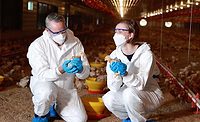No longer is it a leap of faith to believe that a ductless fume hood could be as effective as a traditional hood. It is now a reality. Captair® solutions protect laboratory personnel when working with chemicals. You get total filtration of toxic gases, fumes, odors and powders.
How an Erlab Ductless Enclosure Works
A ductless enclosure is a safety device used to protect laboratory workers when handling chemicals that pose an inhalation risk. These enclosures are equipped with filtration technology that is specific to the type of chemicals handled. These filters capture toxic molecules and particles evaporated in the hood and make it possible to protect users in an effective manner, reducing the carbon footprint by not releasing any toxic emissions into the atmosphere, reducing operating costs due to their very low energy consumption and, last but not least, eliminating all setup costs related to the installation of a ducted airflow system.
Weber Scientific distributes Erlab products to a variety of food and beverage companies. According to President Fred Weber, if the carbon filter in just one Erlab fume unit was flattened out, it would cover all of Manhattan Island.
The Process
1. Air from the laboratory enters the hood through ergonomic openings. The air face velocity creates a dynamic barrier between the user and the chemicals being handled.
2. The device ventilation system draws the particles and any molecules that have evaporated in the hood toward the filtration system. The level of containment provided by the hood prevents any pollutants from being released into the laboratory.
3. The filtration technology customized to the application traps the molecules that have evaporated within the enclosure. The discharged air is free from all pollutants.
4. The continuous recirculation of the filtered air helps purify the ambient air of the laboratory.
Every Erlab Ductless Enclosure Is Analyzed for Your Application
There is a published chemical listing that clearly states what the filters can do. Erlab’s in-house lab tests the retention capacity of all filters and publishes a list stating the chemical name, the molecular weight, grams the filter can retain and under what conditions, the filter type needed to retain the chemical and the type of saturation detection you need. This testing also proves that during normal operation or during detection, the concentration at the filter exhaust will be lower than 1 percent of the threshold limit value (TLV). If there is a spill, the concentration at the filter exhaust will be less than 50 percent of the TLV.
Every Hood Is Custom-Verified that It Is Right for Your Chemical Handlings
Your specific chemical handlings are analyzed by the in-house test laboratory. Determination is made whether your chemical handlings can be done safely using an Erlab hood and filters. If yes, you’ll be advised of the filter type that is needed, the filter lifetime and the best method to detect saturation. A certificate that gives the precise details of the chemicals to be used, the filter type and an estimation of the filter life expectancy is provided and posted on the front of the hood.
A safety specialist from Erlab regularly follows up with you to be sure the hood is working properly, checks to determine whether any chemicals used in the hood have changed and informs you when your filters need replacement.
Technology That Offers Flexibility
The configurable design of the filtration column makes the CaptairFlex line of ductless fume hoods adaptable to the needs of most chemical applications. The ability to stack carbon and HEPA filters allows the filtration column to be configured specifically for the applications carried out within the hood.
No ductwork is necessary, allowing your unit to be up and running in minutes. It installs completely without tools and is entirely mobile and easy to relocate within your lab or to a new building.
The unit eliminates the energy consumption linked to the air renewal, and it has a very low energy consumption, ranging from 70 W to 261 W.
Verified Safety Standards
Captair adheres to the highest safety standard in the world for ductless fume hoods: AFNOR NFX 15-211: 2009, as recognized by ANSI Z9.5-2012. This standard guarantees that the emissions concentration at the filter exhaust will always be lower than 1 percent of the TLV.
Many Models and Configurations to Choose From
Along with a wide range of ductless fume hoods (above right: hood model M321 with a cost of around $3,000), there are vented storage cabinets (above left: cabinet model 812 for $950), HEPA-filtered enclosures and the new Halo laboratory air filtration system that is suitable for an entire laboratory.
www.weberscientific.com
Erlab Ductless Fume Hoods Are Over 99% Effective!







